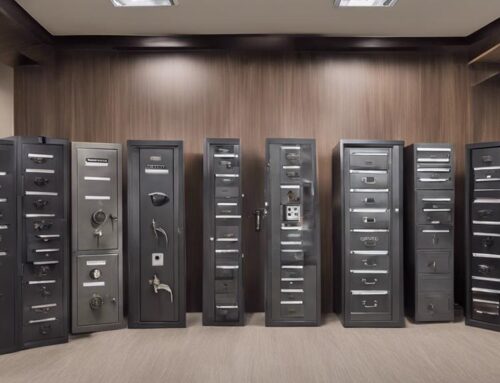Revealing the secrets of electronic locks is like opening Pandora’s box of security innovation. You’ll find these advanced systems offer keyless entry, biometric authentication, and remote monitoring. Choosing the right lock requires understanding types, access management, and installation nuances. Low Rate Locksmith guides you in ensuring compatibility and compliance, while expert maintenance maximizes protection. Discover how these features can transform your security approach and keep your premises secure.
Key Takeaways
- Electronic locks include magnetic, keyless, electric strike, cylindrical, mortise, and passive types for varied security needs.
- Access management systems enhance security by controlling and monitoring entry to authorized personnel only.
- Regular maintenance, including battery checks and lubrication, ensures electronic locks function smoothly and reliably.
- Biometric and token-based authentication methods provide advanced security features for electronic locks.
- Professional locksmith services offer installation, troubleshooting, and compliance assistance for electronic lock systems.
Types of Electronic Locks
When you’re considering electronic locks, understanding the different types based on mechanism is essential for making an informed decision. Magnetic locks offer a secure hold using an electromagnet and armature plate, ideal for robust security needs. Additionally, keyless entry systems enhance security by eliminating traditional keys, reducing unauthorized access. Electric strike locks guarantee easy access by releasing the door upon electrical activation, making them perfect for controlled entry points. Electric cylindrical and mortise locks blend traditional aesthetics with modern technology, offering fail-safe or fail-secure options for varied security requirements. For swift exits, electric push bar locks are your go-to, especially for non-primary metal doors. Passive electronic locks present a power-free solution, ideal for outdoor or industrial settings, with flexible authorization and auditing capabilities. High-security locks provide enhanced protection against unauthorized access, allowing for tailored security solutions. Each type caters to specific needs, allowing for tailored security solutions. By choosing the right mechanism, you’re guaranteeing efficient and innovative security measures that align with your specific requirements, paving the way for advanced protection in any environment. Integrating these electronic locks with smart home systems enhances convenience and allows for remote monitoring, providing an added layer of security.
Key Control and Access Management
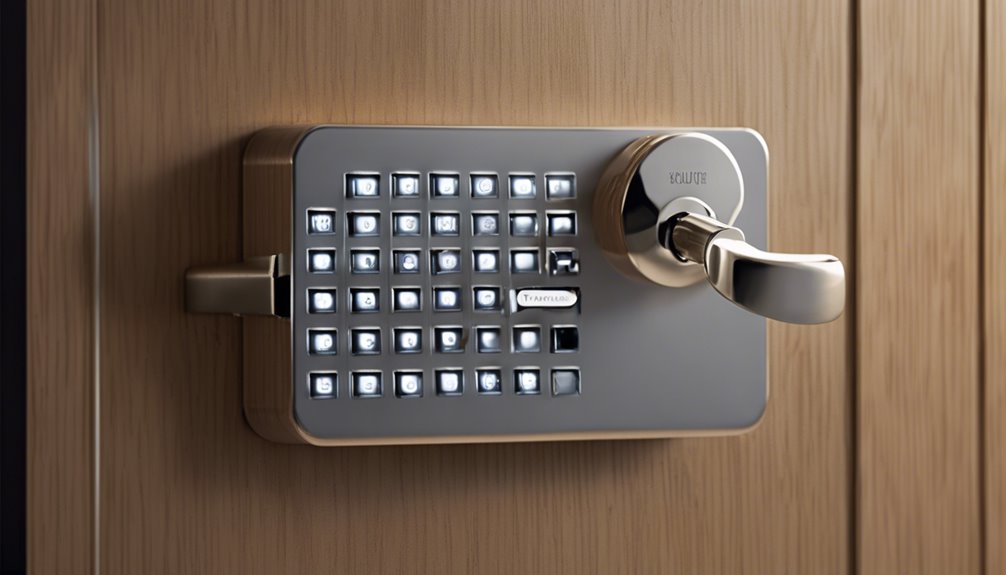
In managing key control and access, you can streamline operations by efficiently adding and removing keys through electronic systems that guarantee security and accountability. Electronic key management systems are designed to manage and track keys, providing peace of mind regarding the security of assets and facilities. Additionally, implementing access controls can enhance security measures further by limiting entry to authorized personnel only. Implement access time restrictions to limit key availability, which reduces unauthorized access during off-hours and enhances asset protection. By customizing key management settings, you can optimize security protocols to fit your specific operational needs and maintain compliance with industry standards. This kind of system can be effectively integrated with comprehensive security systems that include additional layers of protection for businesses.
Key Addition and Removal
Although managing keys can be complex, electronic key management systems streamline the process with rigorous controls and automated features. When you add a key, authorization is a must, ensuring only approved personnel can initiate the process. The system automatically tracks keys, minimizing manual errors and boosting security. Each key addition integrates seamlessly with the software, offering a detailed audit trail. Secure storage in electronic cabinets safeguards against unauthorized access. Regular rekeying of the locks associated with these systems further enhances overall security, as it improves key control by preventing past keys from accessing restricted areas.
For key removal, authorized access is essential, and every action is logged automatically. You receive real-time notifications, enhancing your security monitoring. Keys must be returned to their designated slots, ensuring they’re accounted for and secure. Here’s how these systems innovate:
- Electronic Access Control
- Automated Tracking
- Real-Time Notifications
- Secure Storage
Access Time Restrictions
Access time restrictions in key control and access management greatly enhance security by providing precise control over who enters a facility and when. Unlike traditional keys, electronic access control (EAC) systems offer time-based restrictions, allowing you to specify exact access times, reducing security risks. You can instantly adjust permissions remotely via cloud-based solutions, offering flexibility and innovation. Traditional key systems fall short, lacking time constraints and requiring physical rekeying, which is time-consuming and costly. Electronic locks, however, offer real-time management, instant lockdown capabilities, and advanced credentialing like biometrics. Additionally, they store detailed audit trails and send alerts for unauthorized attempts, providing a thorough security solution. Regular security audits foster a culture of security, making EAC systems even more effective for enhanced, time-sensitive access management and secure your facilities efficiently.
Security Features and Benefits
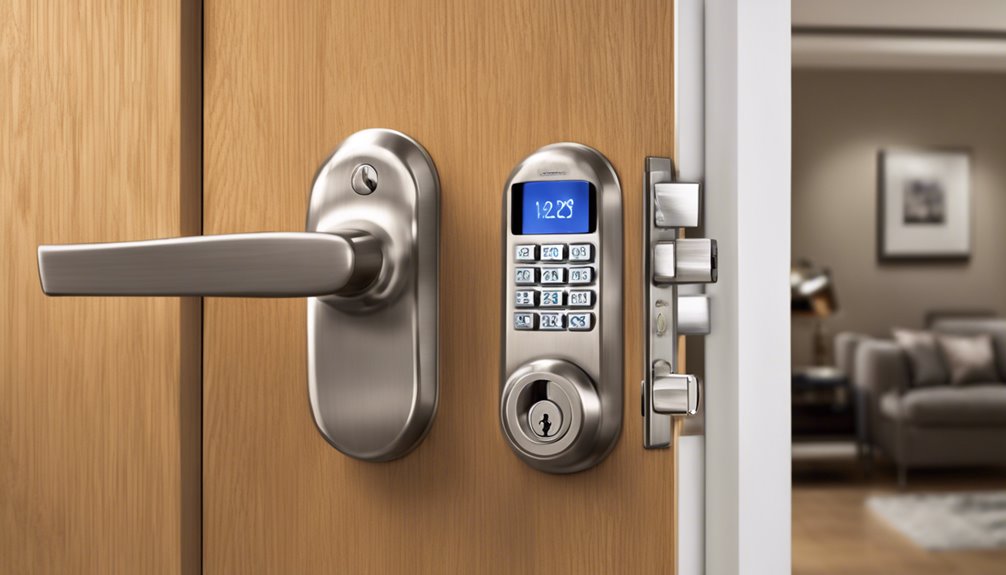
With electronic locks, you gain enhanced access control through advanced verification methods such as biometrics and multi-factor authentication, reducing the risk of unauthorized entry. Regular maintenance is essential to ensure lock functionality and prevent potential operational issues. Remote monitoring capabilities let you manage lock status and receive real-time notifications on your mobile device, ensuring you’re always informed of access attempts. By integrating these features, you can greatly improve security while maintaining convenience and control over your property. Additionally, considering your specific safety and security needs is crucial for optimizing the effectiveness of electronic locks.
Enhanced Access Control
Ensuring robust security in modern access control systems, electronic locks offer a suite of enhanced features that greatly improve safety and compliance. By incorporating advanced technologies, these systems provide secure, efficient, and innovative solutions for access management. Key features include:
- Audit Trail Capability: Track every access attempt, ensuring compliance and enhancing security through detailed records.
- Multi-Factor Authentication: Implement two-factor authentication for added security, requiring users to verify their identity with multiple credentials.
- Time and Role-Based Access: Customize access schedules for users, enhancing control over who can enter restricted areas and when.
- Biometric Access Control: Use facial recognition and other biometric tools to verify identities securely and accurately.
These features eliminate key sharing, reduce unauthorized access, and offer scalable, flexible solutions for evolving security needs.
Remote Monitoring Capabilities
Building on the robust security provided by enhanced access control, electronic locks further elevate safety with advanced remote monitoring capabilities. You can manage access through a web-based interface, leveraging encryption protocols like AES 128-bit to safeguard data. Real-time access logs keep you informed about who enters or exits, while tamper alerts notify you of unauthorized attempts. With standalone device access, you monitor from anywhere, integrating seamlessly with keyless entry systems. Benefit from features like remote key blocking and multi-factor authentication to enhance security. Biometric data is securely stored locally, minimizing breach risks. However, remain vigilant against potential hacking or technical malfunctions by keeping firmware updated and ensuring connectivity. Customizable access rights enable flexible and secure management.
Authentication Methods
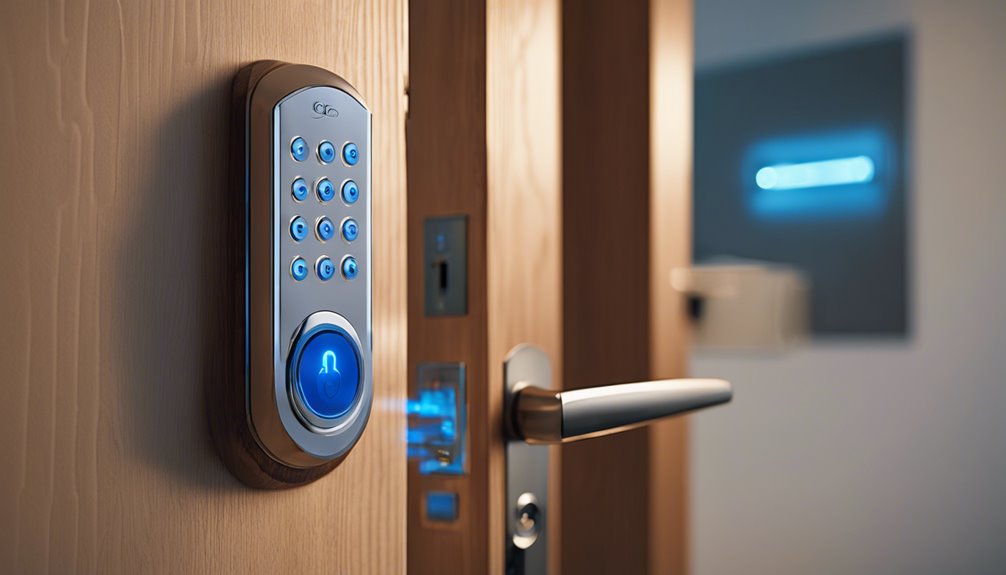
When securing your property with electronic locks, understanding the various authentication methods is essential for ideal security. You can choose from numerical codes, passwords, or passphrases, each requiring a specific sequence for access. For an extra layer of security, some locks provide audible responses to key presses. Additionally, consider security token options:
- Disconnected Security Tokens: They operate on two-factor authentication, adding a robust security layer without needing a physical connection.
- Connected Security Tokens: These require a tangible connection like smart cards, offering secure data transfer.
- Biometric Authentication: Methods such as fingerprint, retinal, and iris scanning provide high-level security, with fingerprint recognition leading the market.
- Additional Options: RFID tags and IoT integration can enhance security and convenience.
For innovative security, biometric methods dominate, ensuring swift and reliable access. Regular updates and two-factor authentication further bolster your lock’s defenses against unauthorized entry.
Installation and Compliance Considerations
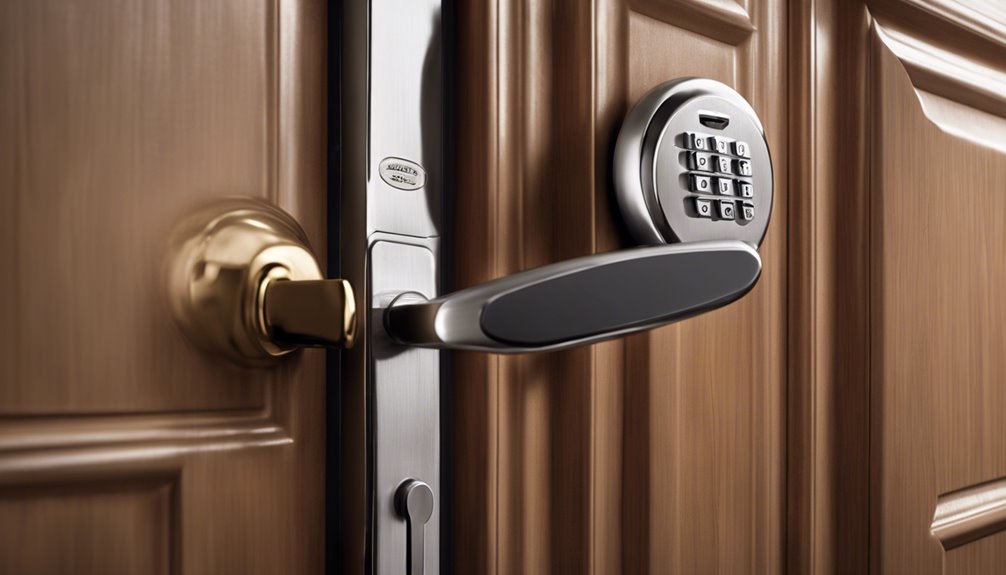
Before installing electronic locks, it’s vital to address key considerations that guarantee a successful setup and compliance with local regulations. First, verify the lock is compatible with your door type and existing hardware. This step prevents installation challenges and guarantees a seamless fit. Assess the power requirements of the lock. Determine if it needs a wired connection or operates on batteries, and plan the installation accordingly to avoid power source issues.
Review local building codes that might affect your installation. Compliance is fundamental to avoid legal complications. Examine the manufacturer’s product specifications and instructions to affirm adherence to specific requirements. This attention to detail will prevent common installation issues, like wiring challenges or compatibility problems.
Prioritize verifying the manufacturer’s warranty and support options, so you’re prepared for any technical issues. By addressing these considerations, you’ll set the foundation for a reliable, innovative electronic lock system.
Maintenance and Locksmith Services
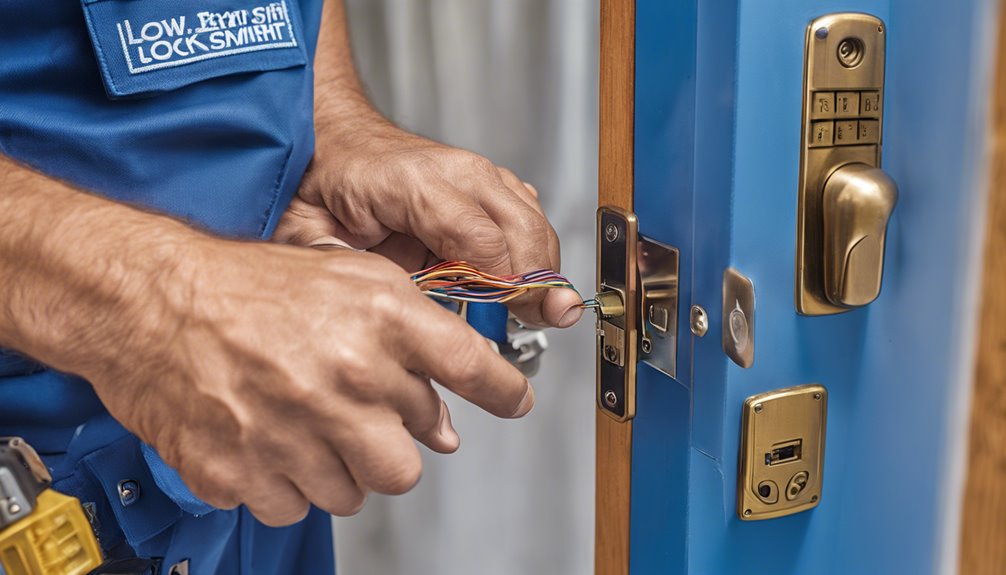
After confirming proper installation and compliance, you must focus on the maintenance and locksmith services for your electronic locks to guarantee they remain reliable and secure. Regular maintenance is essential. Check battery levels frequently to prevent failures and make sure locks operate smoothly. Annually, use emergency keys to keep lock cylinders functional and don’t forget to lubricate handles and bolts. If your locks are exposed to harsh environments, consider more frequent upkeep.
- Battery Level Control: Regularly check battery levels to make sure locks function properly.
- Annual Emergency Opening: Open locks with emergency keys annually to make sure cylinder and switch functionality.
- Annual Lubrication: Apply lubricating oil to handles and bolts once a year.
- 5-Year Adjustment: Remove security escutcheons to adjust screws on handles and clean accumulated dust every 5 years.
Professional locksmith services are invaluable. From installation to troubleshooting, locksmiths offer tailored solutions for maintaining and securing your electronic locks, making sure they operate with the latest technology and utmost security.
Frequently Asked Questions
How Do Electronic Locks Handle Extreme Weather Conditions?
You’ll find that electronic locks handle extreme weather by utilizing high-quality batteries and insulation to minimize temperature impact. In cold weather, battery efficiency drops, causing slower response times. Hot temperatures can lead to overheating issues. Opt for weatherproof locks with durable materials and regular maintenance for peak performance. Consider locks with larger buttons for usability in harsh conditions. Innovative designs guarantee these locks withstand extreme climates better than traditional ones.
Can Electronic Locks Be Hacked or Tampered With Easily?
Yes, electronic locks can be hacked if they’re not properly secured. You need to be aware of Bluetooth vulnerabilities, like sniffing and spoofing, which can compromise your lock. Make certain your locks use strong encryption and regularly update their firmware to patch vulnerabilities. Opt for reputable brands that focus on security innovation. Utilize advanced authentication measures and configure network connections properly to protect against unauthorized access and enhance your lock’s resilience.
What Happens if an Electronic Lock’s Software Malfunctions?
When your electronic lock’s software malfunctions, it can feel like your home’s security is teetering on a knife’s edge. You’ll notice symptoms like unresponsiveness or random locking behavior. Start by checking the batteries and power supply. Consult the user manual for troubleshooting steps or perform a system reset. If issues persist, contact customer support for guidance. Regular updates and maintenance can prevent future glitches, ensuring your innovative security system remains reliable.
Are There Privacy Concerns With Transaction Logging in Electronic Locks?
You’re right to be concerned about privacy with transaction logging in electronic locks. Logs can expose sensitive info like access times or biometric data, posing tracking risks. Guarantee encryption and secure storage practices to protect against unauthorized access. Comply with data protection laws to avoid fines. Innovatively, limit log access, use strong masking techniques, and provide transparency. Address these issues to enhance security and maintain user trust in smart lock systems.
How Does Battery Life Impact the Performance of Electronic Locks?
You might think battery life isn’t vital, but it directly affects your electronic lock’s reliability. Low battery can unexpectedly lock you out, despite energy-efficient designs. Keep an eye on power-intensive features like WiFi and Bluetooth; they drain battery faster. Utilize high-quality batteries and adjust connectivity settings to maximize life. Embrace innovation with advanced power management systems to guarantee your lock remains efficient and dependable, even under demanding conditions.
Conclusion
You’ve grasped the gamut of electronic locks, from types to tight security features. With key control and crafty access management, you’re equipped to enhance your entryways. Authentication methods add another layer of leverage, ensuring safety. Seamless installation and stringent compliance considerations are essential. Don’t forget diligent maintenance and dependable locksmith services to sustain security. With these insights, you’re ready to revolutionize your residence or business with robust, reliable electronic locks.


